Λιμνι Στυμφαλια
Limni Stymphalia - Stymphalian Lake
Useful Information
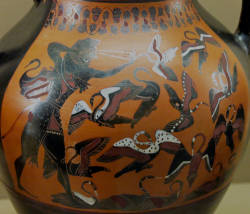
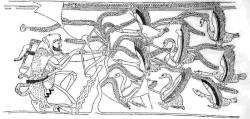
| Location: |
27 km west of Nemea, northwest Argolis.
(37.855626, 22.459530) |
| Open: |
no restrictions. [2022] |
| Fee: |
free. [2022] |
| Classification: |
 Karst lake, Karst lake,
 Ponor. Ponor.
|
| Light: | n/a |
| Dimension: | L=3.5 km, W=1.5 km, Dmax=4 m, Davg=1.5m, Ar=1309 ha, A=620 m asl. |
| Guided tours: | self guided |
| Photography: | allowed |
| Accessibility: | yes |
| Bibliography: | |
| Address: | |
| As far as we know this information was accurate when it was published (see years in brackets), but may have changed since then. Please check rates and details directly with the companies in question if you need more recent info. |
|
History
| 1978 | lake becomes almost completely dry during a drought. |
| 1989 | lake becomes almost completely dry during a drought. |
| 1993 | lake becomes almost completely dry during a drought. |
Description
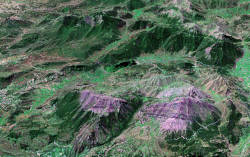
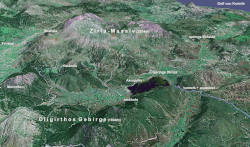

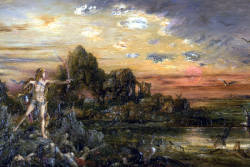
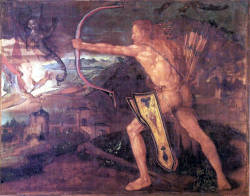
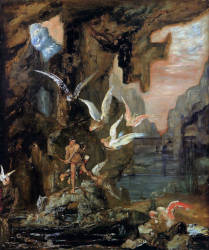
About 27 km west of Nemea, in a wide valley of the northwest Argolis is the location of Λίμνη Στυμφαλία (Lake Stymphalia). The lake is relatively small but nevertheless the most important natural lake in the Peloponnese. The shallow lake is only between 0.5 m and 2.5 m deep. Its catchment area is 218 km². It is located in a quite irregular polje.
This lake is a typical
 karst lake.
It has numerous inlets, but no surface drainage.
The lake is a seasonal lake, it only exists in winter during the winter rains, its maximum size is 7.7 km².
In spring the lake begins to disappear, leaving behind a green and wet, sometimes swampy plain of about 3.5 km².
In dry summers it dries out completely and leaves behind a flat, brown, and dry plain.
karst lake.
It has numerous inlets, but no surface drainage.
The lake is a seasonal lake, it only exists in winter during the winter rains, its maximum size is 7.7 km².
In spring the lake begins to disappear, leaving behind a green and wet, sometimes swampy plain of about 3.5 km².
In dry summers it dries out completely and leaves behind a flat, brown, and dry plain.
The inlets of the lake are the streams Kastaniotikos, Lykorema, Sofeneto, Koliou, Agia Sotira, Rapi, and Stymphalos. There are numerous karst springs, namely Kastania, Kefalovrysos, Kefalari, Drisa, Drosopigi, Velatsouri, and Lafka, which are generall located at the rim of the polje, at the foot of the surrounding mountains. Notable are the spring at the nearby village Stymphalia, north of the lake, and the Kefalari spring which is
The drainage of the lake are Kathavothres
( swallow holes).
The most famous are Gidomandra and Fortsa.
Strabon, the ancient geographer and historian (64/63 B.C. to 23 A.D.), described this strange behaviour and localized the resurgence at Kefalari, south of Argos.
He wrote “the waters of Stymphalia disappear into a land gap and appear again in Argolida, where they form the river Erasinos".
The water flows 35 km underground southeast to the spring.
Modern hydrology later verified this statement.
swallow holes).
The most famous are Gidomandra and Fortsa.
Strabon, the ancient geographer and historian (64/63 B.C. to 23 A.D.), described this strange behaviour and localized the resurgence at Kefalari, south of Argos.
He wrote “the waters of Stymphalia disappear into a land gap and appear again in Argolida, where they form the river Erasinos".
The water flows 35 km underground southeast to the spring.
Modern hydrology later verified this statement.
The lake also has a part in Greek mythology.
This was the place of the man-eating Stymphalian Birds.
These birds were killed by demigod Heracles aka Hercules in his sixth labour for Eurystheus.
Heracles was not able to enter the marsh, to reach the nests of the birds, as the ground did not support his weight.
Athena gave him a rattle called krotala, which Hephaestus had made especially for this use.
Heracles shook the krotala on a cliff overhanging the lake and frightened the birds into the air.
Then he shot and killed many of them with feathered arrows, tipped with poisonous blood from the slain Hydra.
(the second labour, see
 Lerna).
Some birds survived as he could not kill all of them, and flew far away, never to plague Arcadia again.
Heracles brought some slain birds to Eurystheus as proof of his success.
Lerna).
Some birds survived as he could not kill all of them, and flew far away, never to plague Arcadia again.
Heracles brought some slain birds to Eurystheus as proof of his success.
In some versions of this legend the labour was discounted because of the help of Athena.
According to the legend of the Argonauts the surviving birds made a new home on the island of Aretias in the Euxine Sea, where the Argonauts later encountered them.
According to Mnaseas, they were the daughters of Stymphalus and Ornis.
They were killed by Heracles because they did not receive him hospitably.
In the temple of the Stymphalian Artemis they were represented as birds, and behind the temple, there were white marble statues of maidens with birds’ feet.
Later, during Roman times, the water of the lake was used as drinking water. The overflowing waters were redirected to the Vochaikos Chandakas canal and through the ancient Aqueduct of Andrianus to the Asopos river and to the lowlands of Korinthia. The aqueduct was named after Emperor Andrianus, as it was built during his reign. Since then - for 1,800 years - the water of the lake was sustainable managed quite successfully. But today it is threatened by the continuous pumping of its water for irrigation. Chemical fertilisers have transformed it into an eutrophic lake, and despite the efforts of various conservancies it is close to total drying and extinction of the local flora and fauna. At the moment the lake is still famous for its birds, as it is a renowned bird and nature sanctuary. It also hosts eight species of amphibians: fire salamander, greek newt, common toad, green toad, tree frog, balkan frog, greek frog and agile frog. The Peloponnese lizards, the peloponnese slow worm, the greek algyroides and the peloponnese wall lizard are endemic.
The Μουσείο Περιβάλλοντος Στυμφαλίας (Museum of the Environment of Stymphalia) at its northern shore is well worth a visit. But it concentrates on the wildlife, not the karst. Also, on the northern shore lies Σπήλαιο Λίμνης Στυμφαλίας (Cave of Lake Stymphalia), a karst cave noted for its fine speleothems. It is mentioned on ecotourism websites, but as far as we know there is currently no cave trekking tour to the cave offered.
- See also
 Search DuckDuckGo for "Lake Stymphalia"
Search DuckDuckGo for "Lake Stymphalia" Google Earth Placemark: Lake Stymphalia
Google Earth Placemark: Lake Stymphalia Google Earth Placemark: Cave of Lake Stymphalia
Google Earth Placemark: Cave of Lake Stymphalia Stymphalian birds - Wikipedia (visited: 21-DEC-2022)
Stymphalian birds - Wikipedia (visited: 21-DEC-2022) Lake Stymphalia (Important Birds Areas of Greece)
Lake Stymphalia (Important Birds Areas of Greece) Excavations of ancient Stymphalos
Excavations of ancient Stymphalos Stymphalia lake (visited: 21-DEC-2022)
Stymphalia lake (visited: 21-DEC-2022)
 Index
Index Topics
Topics Hierarchical
Hierarchical Countries
Countries Maps
Maps